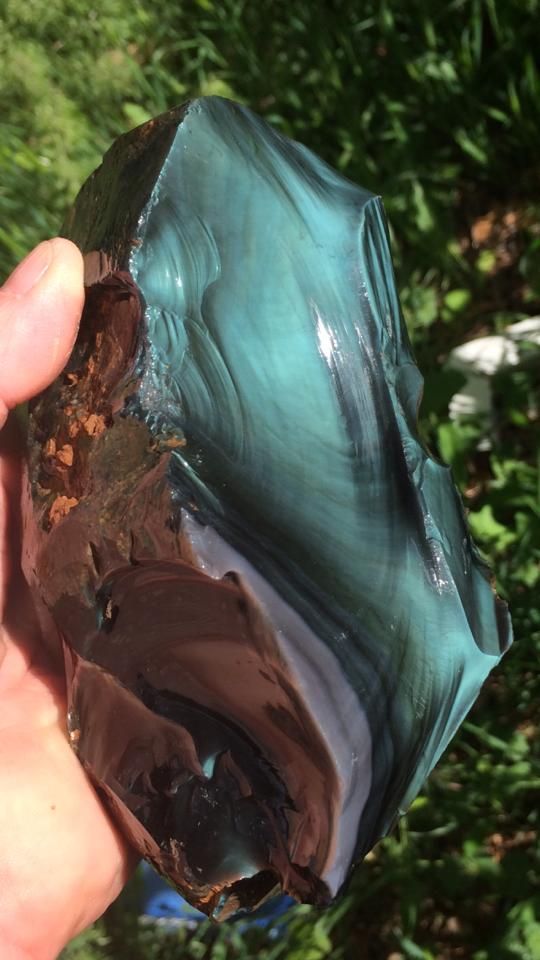|
|
Post by gingerkid on Oct 9, 2014 7:30:50 GMT -5
Purchased a piece of blue 'obsidian' from the Eifel Mountains, Germany to add to the rock collection. The locality has an impact crater, volcanoes, and is where the beautiful blue gemstone, hauyne, is found.  Natural blue 'slag' glass from Eifel Mountains, Germany After researching the material since I never heard of blue obsidian, I read on Mindat that it is not actually obsidan, but volcanic glass. Posted questions about it on the Gem Addicts forum, and found out it's a natural slag glass. Even after receiving answers for what the material should be called, I'm a bit confused as to why it is not obsidian?? (halp!!) Discussion from Mindat: www.mindat.org/mesg-55-212334.html Gem Addicts: gemaddicts.com/forums/index.php/topic,1833.0.html edited to add: ? Not sure why the link to GA didn't post correctly, but if you're interested in reading it, please highlight the link location, then copy and paste it into the address bar. I'm sorry. |
|
spiritstone
Cave Dweller 
Member since August 2014
Posts: 2,061 
|
Post by spiritstone on Oct 9, 2014 7:58:05 GMT -5
Interesting... its not OB? Odd, volcanic made.
|
|
alan
starting to spend too much on rocks
 
Member since December 2013
Posts: 111 
|
Post by alan on Oct 9, 2014 8:03:32 GMT -5
Manning fused glass from SE Texas is similar... It comes from a volcanic tuff that spontaneously ignited after it became saturated with methane supplied from a lower lignite bed. The examples I have seen are blue gray with spots of orange brown... I was skeptical about it being slag myself until I found an article written by a well respected sedimentologist that described localities and even a pseudo-basalt occurence in an area that held more methane.
|
|
|
|
Post by gingerkid on Oct 9, 2014 8:45:34 GMT -5
Thank you, alan, for your reply.  Can the article you mentioned in your post be read online? I would like to read it if you have a link to it. spiritstone, from the Mindat discussion, one mentions that the 'glass' material is only mm's thick. I read that it is a melted xenolith and it does not have the genesis to be called obsidian. I don't think obsidian is transparent, but then there's some of the triple-flow mahogany obsidian that has clear areas in it...  One posted in the discussion that he thought it was "lechatelierite (silica-glass), xenolitic quartz crystals molten by the heat of the lava." Last mention on the German material says it's a natural silica-rich glass. Fulgerites are a variety of the mineraloid lechatelierite.  |
|
jamesp
Cave Dweller 
Member since October 2012
Posts: 36,612
|
Post by jamesp on Oct 9, 2014 9:15:08 GMT -5
Very interesting. Never knew there was a difference in OB and volcanic glass. Will you cab it Jan ?
The Mindat discussion was cracking me up-yes no yes no no no yes no no no-I see why the confusion LOL.
|
|
Fossilman
Cave Dweller 
Member since January 2009
Posts: 20,723 
|
Post by Fossilman on Oct 9, 2014 10:12:52 GMT -5
I like it............Yes interesting!!
|
|
jamesp
Cave Dweller 
Member since October 2012
Posts: 36,612
|
Post by jamesp on Oct 9, 2014 10:49:47 GMT -5
I am tumbling a batch of crazy obsidians Jan. Some are gray and some have a purple sheen.
But blue, not.
|
|
|
|
spiritstone
Cave Dweller 
Member since August 2014
Posts: 2,061 
|
Post by spiritstone on Oct 9, 2014 11:37:35 GMT -5
Thank you, alan, for your reply.  Can the article you mentioned in your post be read online? I would like to read it if you have a link to it. spiritstone, from the Mindat discussion, one mentions that the 'glass' material is only mm's thick. I read that it is a melted xenolith and it does not have the genesis to be called obsidian. I don't think obsidian is transparent, but then there's some of the triple-flow mahogany obsidian that has clear areas in it...  One posted in the discussion that he thought it was "lechatelierite (silica-glass), xenolitic quartz crystals molten by the heat of the lava." Last mention on the German material says it's a natural silica-rich glass. Fulgerites are a variety of the mineraloid lechatelierite.  So there is a possibility the melted xenolith could be caused from a near impact site? |
|
alan
starting to spend too much on rocks
 
Member since December 2013
Posts: 111 
|
Post by alan on Oct 9, 2014 13:47:29 GMT -5
|
|
|
|
Post by catmandewe on Oct 9, 2014 16:14:41 GMT -5
Actually quite a bit of the Davis Creek obsidian we pulled out was transparent. Some had sheen and some had flow lines.
I also want to know why there is considered a difference between obsidian or natural glass, since obsidian is natural glass.
Tony
|
|
|
|
Post by 150FromFundy on Oct 9, 2014 18:53:05 GMT -5
That looks like obsidian with the characteristic conchoidal fracture, sharp edges and what appears to be faint flow banding (or maybe just reflection), so I'm going with the volcano as the source.
If it were a tektite (molten sand to glass from meteor impact) it should have a more pitted surface, or even appear like a meteorite because it flew through the air while in a molten state. Moldavite from Czech Republic is a good example.
If it were slag glass, it should have an air bubble, or pit in it somewhere, or a fracture. I don't think I have ever seen slag glass without one. Older (turn of the century) slag glass will often fluoresce under LW and or SW fluorescent light due to the early colour additives. if it fluoresces, it probably is slag glass after all.
This debate may not end just yet.
Darryl.
|
|
|
|
Post by gingerkid on Oct 10, 2014 9:51:30 GMT -5
Thank you, alan, for the link to the article. jamesp, I will probably keep it as a specimen instead of cabbing it. I haven't cabbed or tumbled any obsidian yet. Wow, that's a gorgeous piece, deserthound!!  Thank you, Fossilman, for your kind comments. Thanks for your explanation, 150FromFundy. When you mentioned, 'pits,' in slag glass, is that what the round indentation might be that you can see in the front of the material in the picture I posted? I have 3 pieces of the material, and each piece has a 'hole,' or a couple of 'em, in it. The hole only goes a couple of mm's into the material and range in size. |
|
|
|
Post by Pat on Oct 10, 2014 9:58:36 GMT -5
Very interesting discussion. I have a piece like your blue one, and a similar green piece. Solid colors, not sheens as we see in our Davis Creek obsidians. Will read all this later.
I thought "natural glass" and obsidian were synonymous.
|
|
deserthound
spending too much on rocks
 
Member since December 2013
Posts: 390 
|
Post by deserthound on Oct 10, 2014 15:44:52 GMT -5
interesting article about obsidian @ gemrock obsidian-central michigan university
|
|
Deleted
Deleted Member
Member since January 1970
Posts: 0
|
Post by Deleted on Oct 10, 2014 18:18:19 GMT -5
seems someone is splitting hairs for marketing reasons.
|
|



 Can the article you mentioned in your post be read online? I would like to read it if you have a link to it.
Can the article you mentioned in your post be read online? I would like to read it if you have a link to it. 












